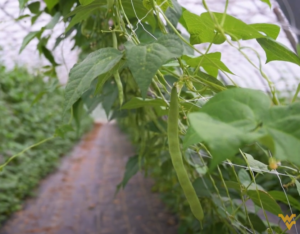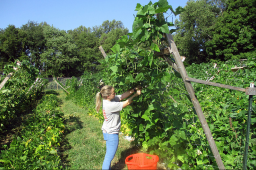Final report for ONE19-338
Project Information
The heritage bean project sought to determine marketable yield and answer whether products are economically viable beyond direct markets. We explored a slant cross-arm trellis system versus a vertical system to determine hand harvest rate and time per pound for evaluation. We partnered with five farms to test twelve different heritage bean varieties, including “half-runners” and pole beans. From the research it was concluded that slant-cross arm trellises improved efficiency by effectively separating bean pods from the canopy allowing for a faster harvest of marketable yield. The largest significant difference was shown between the Volunteer variety with 378.9 lbs fresh weight picked per 100 ft. row on a cross-arm in the same amount of time to pick 175.9 lbs. fresh weight per 100ft. row on a vertical trellis system, with a 203 lb difference in trellis type.
Through this project, we reached at least 78 participants through direct contact education. More than a dozen on-on-one consultations were accomplished on farms in addition to digital media with the creation of five related YouTube videos.
The largest impact of this project is seen in the extended connections. This project brought together heritage seed collectors and educators from across the West Virginia. Seeds saved from the research farms allowed for distribution of 5,000 bean seeds through the Grow This! West Virginia gardening program. The interest in growing via high tunnels allowed for new collaborations and a $60,000 USDA NRCS grant to be awarded.
This project seeks to determine marketable yield of heritage beans and answer the question if they are an economically viable product beyond direct markets. For this objective, the project will explore the growing methods of the cross-arm trellis system and will determine the hand harvest rate and time per pound as an evaluation. We will conduct the heritage bean study on five partner farms with twelve varieties each.
We will assess wet chemistry protein and fiber values for twelve different varieties of heritage beans. We will investigate consumer preferences by doing taste testing studies, from which we will evaluate feedback of physical attributes including taste, texture and color. We will also identify purchasing consideration preferences during this process.
We will discuss the results of the grower experiences and overall project, including customer expectations, and make recommendations to County Agricultural Agents and service providers. This dissemination of information will allow farmers across the state to make informed marketing decisions for their operation.
Fresh and dry beans (Phaseolus vulgaris) have been grown in the Appalachian region for thousands of years and have a long history as a food crop in the region. Many of the bean varieties have been selected by local seed savers and are adapted genotypes to the ecoregion. There is an increasing demand for heritage food crops across the United States. The majority of the heritage bean varieties grown in Appalachia are indeterminate and require trellising for harvest. Since harvest cannot be mechanized, designing a trellis which can improve manual harvest efficiency of heritage types would be useful for growers wishing to produce heritage beans for commercial fresh and dry bean markets. In addition, the large number of new high tunnels in West Virginia provide a controlled environment for early-season bean production and marketing. The objective of this research and outreach project was to evaluate high tunnel, early-season yield and field production of heritage beans grown using angled or slant-arm trellises for harvest in West Virginia.
Cooperators
- - Producer
- - Producer
- - Producer
- (Researcher)
- (Researcher)
- - Producer
- - Producer (Researcher)
- - Producer
- (Educator and Researcher)
Research
Five “half-runner” bean varieties were chosen for evaluation. The half-runner type of bean produces laterals or “runners” which extend ≈9-12 feet and produces a green bean with one string/pod. The seed is just beginning to form in the pod when half-runner beans are harvested. The plants are indeterminate which requires multiple harvesting over an 8-12-week period.
Three types of trellises were evaluated for commercial production systems. The standard method of trellising pole for half-runner types is a vertical trellis in which the beans are supported on mesh netting or wire and metal posts with tensile wire for bracing. These types of trellises are typically 84 inches in height and can accommodate 2 rows of beans per trellis.
We decided to redesign a trellis for beans that is a version of the cross-arm trellis used for brambles. With this trellis, the vines grow at an angle (30-40⁰) and the pods separate from the canopy for ease of harvest (Figure 1). We also hypothesize that this trellis reduces the level of interplant shading and could increase the photosynthetically active radiation (PAR) to leaf canopy.
Two styles of angled trellises were evaluated. One design had 2 cross-arms angled 40⁰. Each row of a 2-row bed was grown on separate arms and the canopy had a V-shape growth. Each arm was 7 feet in length and was constructed from untreated, pine lumber. Hortonova netting was stapled between the arms to provide a support for the runners. The other style used a single panel which was 9 feet in height and angled 40⁰ from vertical. Both rows were trained on the individual panel, and the canopy was oriented leaning north since the rows ran east to west. Vertical trellis were established by placing 7-foot metal posts every 15 feet and suspending Hortonova netting on the posts.
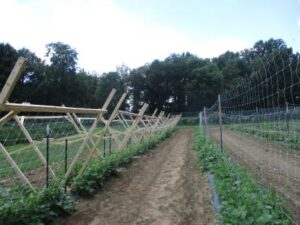
Field Evaluations:
The beans were planted on June 6, 2019 at the WVU Horticulture Organic Farm near Morgantown, WV. The soil is a silt loam with a pH of 6.5. Supplemental poultry litter was broadcast and incorporated prior to planting. The beans were seeded on 30-inch wide beds covered with black plastic mulch and drip irrigation. Two rows were seeded per bed with seed planted every 6 inches within a 7-foot plot. There were 3 replications per variety and each variety was completely randomized down the row. Each trellis design was used for an entire row length across all blocks. Supplemental irrigation and Chilean nitrate (12-0-3) was fertigated on plots for additional nitrogen. Organic pesticides were used for blight management and suppression of insects such as Japanese beetle and Mexican bean beetle. Harvest commenced on August 7 and individual plots weighed through September. Harvest time was recorded on select cultivars. Beans were rated for color and overall quality.
High Tunnel Evaluations:
Half-runner and indeterminate roma beans were evaluated for early-season high tunnel production at Sickler Farms in northcentral West Virginia as well as the WVU Organic Horticulture Farm in Morgantown, WV. Direct seeding vs transplant production was evaluated by seeding 2 seeds per cell in a 50-cell Protray filled with Organic Promix BX beginning in mid-March 2019. The transplants were grown in a greenhouse for 3 weeks and transplanted in late March and mid-April on black plastic mulch with drip irrigation within a single poly high tunnel (30 ft x 72 ft). The plants were spaced as a staggered, 2-row bed with each plug containing 2 plants spaced 12 inches apart in-row and the rows 15 inches apart on the bed. A standard vertical trellis supported by Hortonova netting on metal t-posts was used to support the canopy.
At Sickler Farms, beans were planted no-till within a 30 ft x 120 ft double poly high tunnel by using a rye/crimson clover/winter pea cover crop mix which was seeded the previous fall and mowed and tarped in March. A woven ground cover fabric was placed over the cover crop residue and no preplant fertilizer was applied. Drip irrigation lines were placed under the ground cover and the beans transplanted 12 inches apart on a staggered twin row. Trellising used the Hortonova netting with additional strings tied to support pipe to produce a 9-foot trellis (Figure 2). Beans were transplanted as plugs grown as soil blocks (2 inch) on April 15, 2019.

Half-runner and pole beans are trellised for maximum yield and ease of harvest since the vines can grow 9 or more feet. Several styles of trellises can be used for growing heirloom beans. The standard vertical or upright trellis using cattle panels, woven-wire fencing or netting is common. A teepee or maypole trellis can also be used. Another style of trellis evaluated at West Virginia University was a slanted panel (single or double) trellis that improves light interception, resulting in higher yields and greater harvest efficiency of heirloom beans (Figure 3). Trellises are angled at 35 degrees, which facilitates harvest while improving light interception by the canopy.
Figure 3. Half-runner and pole beans can be harvested efficiently with a modified, slanted trellis design.

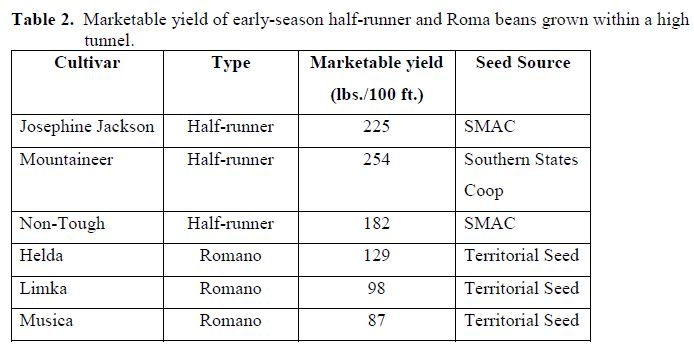
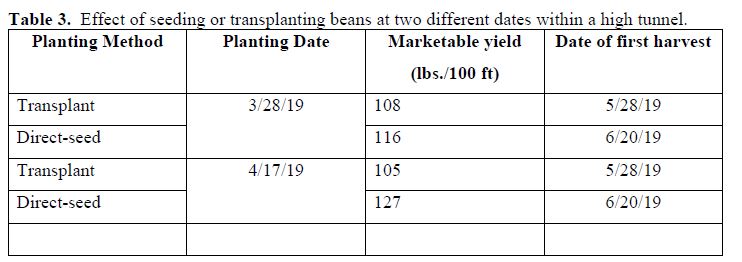
The slant-cross arm trellises improved harvest efficiency by effectively separating the bean pods from the canopy. Harvesters were able to pick quality beans and leave undersized or unmarketable beans on the vine. The vertical trellis was more matted and entangled making it harder for the pickers to see the pods and resulted in a longer harvest time.
Education & outreach activities and participation summary
Participation summary:
2020
No outreach activities were conducted in 2020 due to the pandemic.
2021
Multiple YouTube videos have been created to assist with project outreach and promotion:
- Trellising Heirloom Beans, https://youtu.be/AWdGFxFs0so
- Farm to Plate in the Mountain State: WVU Organic Farm and Evansdale Greenhouse, https://youtu.be/P4kNTxj62Bk
- Trellising with Lewis Jett, https://youtu.be/0WxGU1J_Q2E
WVU Davis College of Agriculture, Natural Resources and Design and WVU Extension Service hosted the annual Organic Farm Field Day from 2 - 7 p.m. on Saturday, Aug. 28, 2021, which allowed us to promote the heritage green bean project, https://www.davis.wvu.edu/news/2021/08/23/organic-field-day-set-for-aug-28 During this in-person event, there were 55 attendees that engaged in education and tours of the research plots.
With the surge of individuals and families gardening in 2021 as a result of the pandemic, there was also an increased interest in heritage green beans. We partnered with the WVU Extension Service Families & Communities Development Unit, Family Nutrition Program initiative called Grow This! West Virginia, through which we distributed 5,000 green bean seeds. Later information was taken from developed fact sheets and given out to gardeners through handouts and Facebook live videos to address questions.
The Fact Sheet “Growing, Harvesting, Preserving Appalachian Heirloom Beans” listed under “Information Products” was published through the Center for Crop Diversification in February 2021 and as of September 28, 2022 it has been downloaded 1,320 times.
2022
YouTube videos have been created to assist with project outreach and promotion:
- WVU Extension Spotlight: Heritage Bean Project: https://youtu.be/p7hHDrvZxU8
- Farm to Plate in the Mountain State: Sickler Farm: https://youtu.be/MHdp7kdOhI4
A West Virginia University Student Organic Seed Symposium was held July 28-31, 2022. Dr. Lewis Jett presented an overview of the SARE Heritage Bean project during the event and dispersed seed to the group of approximately 30 attendees.
Learning Outcomes
Increase in knowledge about varieties of green beans
Increase in knowledge about use of trellising systems for growing heritage varieties
Increase in knowledge of harvest efficiency using effective trellising systems
Increase in awareness of nutrition content of heritage beans
Project Outcomes
Several hundred pounds of heritage green beans and dry beans were grown and test marketed across West Virginia.
During the 2020 COVID-19 pandemic, the green beans were in high demand as a fresh crop at direct market outlets. Due to the initial stay-at-home mandates, customers were desperate for outdoor activities, which led to increased sales at farmers markets and u-pick operations that were able to comply with increased sanitation requirements and customer-per-square-foot changes.
From this project, one of the participating operations that acts as a farmer incubator was able to train new & beginning farmers in a new method of growing with a trellis system and explored how to grow beans in a high tunnel. This operation was able to market a couple hundred pounds through an online portal and expressed interest in seed saving due to the history of the selected varieties.
There has been a large interest in saving seeds from this project, which has been amplified by the COVID-19 pandemic. The Grow This: West Virginia Garden Challenge provides free seeds to anyone in West Virginia who fills out a short survey. In 2020, as a result of COVID-19 lockdowns, more than 25,000 people signed up to receive seeds. Many were first-time gardeners. As a result of this program, we were able to save seeds each growing season and have been able to distribute more than 5,000 heritage green bean seeds through the Grow This: West Virginia, which were directly saved from the previous year's research crop.
The trellises from the project have been given to farmers that were interested in using them to expand their crop diversification. Eighteen have been given to a farmer in the Buckhannon area, which is the only incorporated city in, and the county seat of, rural Upshur County. This farmer is testing the trellis system on Red Noodle Yard Long Bean, which have a purple-red color and are a well-known variety in southern China. They are also teaching consumers about how to cook and eat these beans. Another farmer has been given sixty trellises to try additional green bean varieties to sell into the Farm to School program and expand a u-pick market.
A major component of this project is studying trellising systems for heritage green bean production. We have tried multiple designs during this project and are still making adjustments based on grower feedback for the position of the strings for the beans to climb when first training as well as the best angles for the structure that produce an easy to harvest crop during the growing season.
Initially the trellis system requires additional labor by the single owner farmers to get in place, but once up we have heard valuable feedback that the system made picking heritage beans more efficient.
Not included in this project proposal initially, there is interest in using the trellis system for u-pick operations as a way to add an additional crop to market that customers would be able to easily harvest. This marketing opportunity should be investigated to determine the viability of the model and to determine if the customer is willing to pay for the capital cost of the trellis system.
The trellis system and marketing potential will benefit any farmers producing pole bean or heritage green bean crops. The population within this project (Central Appalachia) has a cultural connection with these crops. Other regions would need to be explored to determine the value of heritage green beans to communities across the U.S.

